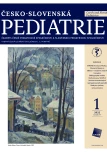Hereditary angioedema in children: what the paediatrician needs to know
Authors:
Hulínková Ivana; Čižnár Peter
Authors‘ workplace:
Detská klinika Lekárskej fakulty Univerzity Komenského a Národného ústavu detských chorôb v Bratislave
Published in:
Čes-slov Pediat 2022; 77 (1): 19-26.
Category:
Original Papers
Overview
Hereditary angioedema (HAE) is a rare genetic disorder characterized by recurrent episodes of localized, bradykinin-mediated swelling of the deep tissues of the skin, respiratory and gastrointestinal tract, which can be life-threatening. In most cases, HAE is caused by C1-esterase inhibitor (C1-inhibitor) deficiency, most commonly due to a mutation in the SERPING1 gene. Symptoms usually begin in childhood or adolescence and worsen towards adulthood. Diagnosis is complicated by the considerable variability of clinical symptoms and/or the presence of concomitant, mainly allergic diseases. In this article, we describe a series of 6 patients from 3 families with genetically confirmed HAE and their clinical phenotype.
Keywords:
hereditary angioedema – diagnostics – C1-inhibitor – bradykinin – case reports
Sources
1. Aygören-Pürsün E, Magerl M, Maetzel A, Maurer M. Epidemiology of Bradykinin mediated angioedema: a systematic investigation of epidemiological studies. Orphanet J Rare- Dis 2018; 13: 73.
2. Bennett G, Craig T. Hereditary angioedema with a focus on the child. Allergy Asthma Proc 2015; 36: 70–73.
3. Davis AE 3rd. The pathophysiology of hereditary angioedema. Clin Immunol 2005; 114: 3–9.
4. Hakl R, Kuklínek P, Chovancová P, Litzman J. Vrozené poruchy komplementu II. – hereditární angioedém. Čes Slov Pediat 2021; 76 (4): 218–221.
5. Donaldson VH, Rosen FS. Hereditary angioneurotic edema: a clinical survey. Pediatrics 1966; 37:1017–27.
6. Farkas H. Pediatric hereditary angioedema due to C1-inhibitor deficiency. Allergy Asthma Clin Immunol 2010; 6: 18–27.
7. Bork K, Meng G, Staubach P, Jardt J. Hereditary angioedema: new findings concerning symptoms, affected organs, and course. Am J Med 2006; 119: 267–74.
8. Maurer M, Magerl M, Ansotegui I, et al. The international WAO/ EAACI guideline for the management of hereditary angioedema - the 2017 revision and update. World Allerg Org J 2018; 11: 5.
9. Farkas H, Martinez-Saguer I, Bork K, et al. International consensus on the diagnosis and management of pediatric patients with hereditary angioedema with C1 inhibitor deficiency. Allergy 2017; 72: 300–313.
10. Roche O, Blanch A, Caballero T, et al. Hereditary angioedema due to C1 inhibitor deficiency: patient registry and approach to the prevalence in Spain. Ann Allergy Asthma Immunol 2005; 94: 498–503.
11. Bygum A, Fagerberg CR, Ponard D, et al. Mutational spectrum and phenotypes in Danish families with hereditary angioedema because of C1 inhibitor deficiency. Allergy 2011; 66: 76–84.
12. Gakhal MS, Marcotte GV. Hereditary angioedema: imaging manifestations and clinical management. Emerg Radiol 2015;22(1): 83–90.
13. Bork K, Hardt J, Witzke G. Fatal laryngeal attacks and mortality in hereditary angioedema due to C1-INH deficiency. J Allergy Clin Immunol 2012; 130: 692–7.
14. Skoczylas D, Gujski M, Bojar I, Raciborski F. Importance of food allergy and food intolerance in allergic multimorbidity. Ann Agric Environ Med 2020; 27(3): 413–417.
15. Cancian M, The Italian Network for C1-INH-HAE (ITACA ). Diagnostic and therapeutic management of hereditary angioedema due to C1-inhibitor deficiency: the Italian experience. Curr Opin Allergy Clin Immunol 2015; 15: 383– 391.
Labels
Neonatology Paediatrics General practitioner for children and adolescentsArticle was published in
Czech-Slovak Pediatrics

2022 Issue 1
Most read in this issue
- Laboratory newborn screening
- Differential diagnosis in paediatric inflammatory multisystem syndrome temporally associated with SARS-CoV-2
- Brief overview of child and adolescent psychopharmacotherapy
- Z historie pediatrie
